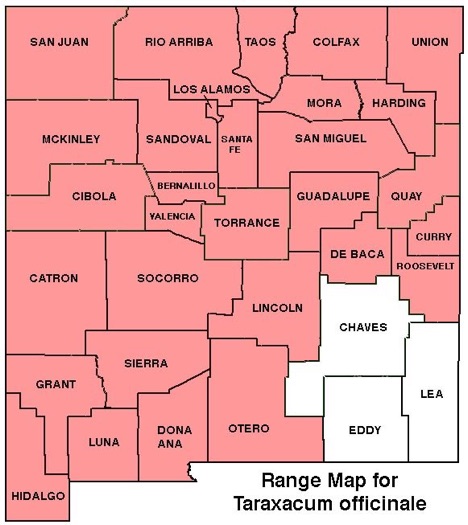WILDFLOWERS OF NEW MEXICO

The little yellow flowers, well know though not so loved as a yard weed, bloom nearly year round. The basal rosette of leaves sprouts from a deep taproot to 3/8-inch in diameter. Note the flower stems grow directly from the rosette of deeply lobed leaves, and the sap is milky.
FLOWER: Can bloom any month. The 1–1 1/2-inch wide (25–38 mm) butter-colored blooms sprout atop a 1–10-inch tall, hollow, leafless stalk. The flower head contains 100–200 ray flowers, no disk flowers. Fruit develops into the sphere of fluffy parachute seeds kids loves to blow in the breeze. The early-blooming flowers are an important source of nectar and pollen for spring-emerging native bees and butterflies.
LEAVES: Basal rosette of leaves. Blades 2–8-inches long (5–20 cm) with pointed, arrowhead-shaped lobes along the midrib.
HABITAT: Disturbed soils, lawns, roadsides; desert grasslands and scrub to high mountain slopes and ridges.
ELEVATION: 2,500–12,000 feet.
RANGE: Introduced and naturalized in every state in the U. S.
SIMILAR SPECIES: The centers of the yellow flowers of Texas Dandelion, Pyrrhopappus pauciflorus, east and west of central mountains in NM, are dotted with black anthers, and the leaves are unlobed.
NM COUNTIES: Widespread on disturbed ground nearly throughout NM (not reported Chaves, Eddy, Lea cos.).
NOTES: All parts of this worldwide “weed” are edible. For salads and pot herbs, the young greens are highly nutritious and tasty, but I’ve found the roasted-root coffee weak and rather tasteless.

DANDELION
TARAXACUM OFFICINALE
Aster Family, Asteraceae
Annual herb; introduced, naturalized



THE CONTENTS OF THIS WEBSITE ARE COPYRIGHTED AND CANNOT BE USED
WITHOUT PERMISSION OF GEORGE OXFORD MILLER

Basal leaves are deeply cut along the midrib into arrow-shaped lobes.

Anthers of the ray flowers are yellow (arrow); no disk flowers are present.

EMAIL ME